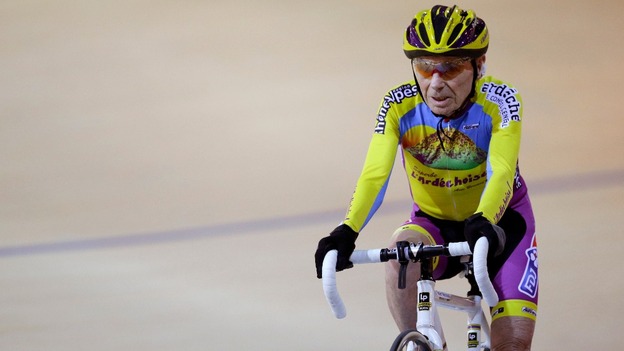By Jane Thornton, MD PhD
Frenchman Robert Marchand’s name has become synonymous with incredible achievement two months ago after setting a new track cycling world record… at 105 years of age. Astounding as this is, it has only served to confirm something many of us sport docs already know: the body is built for adaptation.
 When French researcher Veronique Billat and colleagues put Mr. Marchand on a training plan and studied the results (1), they noticed something remarkable – Marchand was over 100 years of age and more aerobically fit than most 50-year-olds. Even more remarkable – he is still making improvements.
When French researcher Veronique Billat and colleagues put Mr. Marchand on a training plan and studied the results (1), they noticed something remarkable – Marchand was over 100 years of age and more aerobically fit than most 50-year-olds. Even more remarkable – he is still making improvements.
But if this were globally true, why do most health care practitioners see the opposite trend as a general rule? Too many older adults are sedentary, and instead of thriving during these years, they are simply surviving – with complex, chronic diseases. In Canada, for example, 14% are over the age of 65, yet account for almost half of health care costs. These numbers are only expected to rise.
We know the numbers of Masters athletes are climbing and their performances continue to amaze and inspire. Can these stories not push the limits of what we know for ageing and chronic disease as well?
In my opinion, this is one of the most interesting emerging fields to hit sport and exercise medicine in a long time.
We know that there are several positive changes in disease markers in the older adult with an increase in physical activity, but we’re still learning ways to tailor these interventions for optimal effectiveness (2), especially in light of increased hospital visits in this population.
Hospitalization can induce atrophy and profound muscle weakness throughout the course of a relatively short stay, particularly targeting the all-important hip flexors. This can lead to a drop in functional independence and increase fall risk.
A recent prospective cohort study at an academic medical centre in northern Israel (3) evaluated 177 patients over 65 years of age hospitalized in two internal medicine units. With a relatively minor and inexpensive intervention, attaching an accelerometer to a patient’s ankle, they were able to observe that walking more than 900 steps per day (approx. 500m) results in lower hospital-associated functional decline (HAFD). They observed a strong dose-response effect, and the beauty of it was that it is one of the first to link normative data to functional outcomes.
What about those too frail even too walk? Dr. Michelle Kho and colleagues at McMaster University in Hamilton, Ontario, examined in-bed cycling for frail and critically adults in the ICU (4). They found that these patients can safely pedal using a specialized exercise bike that rolls over patients’ beds. Using a built-in motor can move patients’ legs for them or allow them to cycle on their own.
Marchand’s case may help to challenge our beliefs about what is possible to achieve, regardless of how old we are. Outside of the elite older adult’s performance, however, the biggest gains will likely be observed in a growing population – the frail and hospitalized patient.
Studies like Dr Michelle Kho’s and others in the field should give us hope that physical activity earlier on in rehabilitation can reap multiple benefits.
The critical need for research and advocacy for physical activity in the older adult will only intensify as the world’s older adult population continues to grow and their health needs continue to escalate.
When caring for older adults, we physicians should not only be talking about medication, but also about what can be done as an adjunct to therapy or in some cases to replace medication altogether (5). This also means getting older adults involved in preventative measures like strength and balance training before they wind up in the emergency department with a broken hip.
Let’s move beyond counselling on just not being sedentary and encourage our patients to embrace the joys of sport and physical activity at any age.
We may yet come to see that the “Golden Years” become even brighter.
References:
- Billat V, Dhonneur G, Mille-Hamard L, Le Moyec L, Momken I, Launay T, Koralsztein JP, Besse S. Case Studies in Physiology: Maximal oxygen consumption and performance in a centenarian cyclist. J Appl Physiol 2017 Mar 1;122(3):430-434. doi: 10.1152/japplphysiol.00569.2016. Epub 2016 Dec 29.
- Buford TW, Anton SD, Clark DJ, Higgins TJ, Cooke MB. Optimizing the benefits of exercise on physical function in older adults. PM R. 2014 Jun;6(6):528-43. doi: 10.1016/j.pmrj.2013.11.009. Epub 2013 Dec 19.
- Agmon M, Zisberg A, Gil E, Rand D, et al. Association Between 900 Steps a Day and Functional Decline in Older Hospitalized Patients. JAMA Intern Med. 2016 Dec 5. doi: 10.1001/jamainternmed.2016.7266.
- Kho ME, Molloy AJ, Clarke FJ, Ajami D, McCaughan M, Obrovac K, et al. (2016) TryCYCLE: A Prospective Study of the Safety and Feasibility of Early In-Bed Cycling in Mechanically Ventilated Patients. PLoS ONE 11(12): e0167561. doi:10.1371/journal.pone.0167561
- Thornton, J.S., P. Fremont, K. Khan, P. Poirier, G. Wells, J. Fowles, R. Frankovich. Physical activity prescription: a critical opportunity to address a modifiable risk factor for the prevention and management of chronic disease: a position statement by the Canadian Academy of Sport and Exercise Medicine. Br J Sports Med doi:10.1136/bjsports-2016-096291
**********
Jane Thornton, MD PhD, Resident, Physician, Olympic Rower